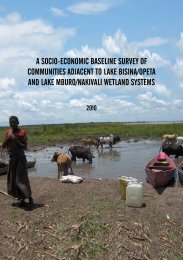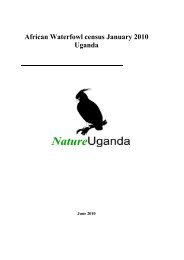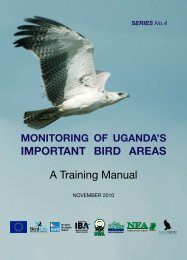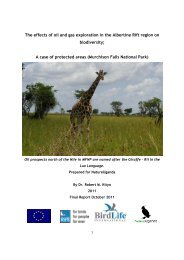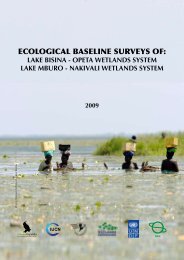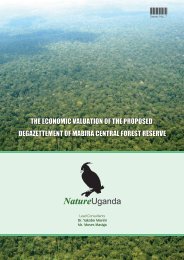Status and Trends 2009 - Nature Uganda
Status and Trends 2009 - Nature Uganda
Status and Trends 2009 - Nature Uganda
Create successful ePaper yourself
Turn your PDF publications into a flip-book with our unique Google optimized e-Paper software.
progress with 2.36±0.17 <strong>and</strong> a slight decline in <strong>2009</strong> with<br />
score of 2.26 ±0.13 (Mean±SEM). This is still good since the<br />
score is above medium as shown in the figure 17 below<br />
Low Medium High<br />
3<br />
2<br />
1<br />
Response <strong>Trends</strong> in IBAs in <strong>2009</strong><br />
0<br />
2000 2002 2004 2006 2008 2010<br />
Year<br />
Fig 17. General trends of response<br />
All IBAs<br />
(b) Response trends of IBAs in three habitat categories<br />
The general trend of responses shows a steady improvement<br />
in all the three habitat classes (Protected Areas, Forested IBAs<br />
<strong>and</strong> Wetl<strong>and</strong> IBAs). The following can be obtained from the<br />
figure 18 as below:<br />
(i) Response trends in National Parks <strong>and</strong> Wildlife Reserves are<br />
the most encouraging of the three management categories.<br />
This is because all the PAs have some level of protection <strong>and</strong><br />
with significant levels conservation activities. The mean scores<br />
for 2008 <strong>and</strong> <strong>2009</strong> of 2.77±0.12 <strong>and</strong> 2.62±0.14 (Mean±SEM,<br />
n=13) for the respective years do not show significant difference<br />
although showing a slight decline as in figure 18 below.<br />
(ii) Response trends in Forest Reserves follow a similar scenario<br />
as PAs with mean scores of 2.5±0.5 in 2008 compared to<br />
2.44±0.16 (Mean±SEM, n=9) in <strong>2009</strong>. This means that,<br />
in terms of conservation activities, protection status <strong>and</strong><br />
management planning, the Forest Reserves are rated second<br />
to National Parks <strong>and</strong> therefore better than the IBAs in the<br />
wetl<strong>and</strong> habitats in terms of conservation actions.<br />
(iii) Responses level (conservation efforts) in wetl<strong>and</strong> IBAs are<br />
still wanting. This registered tremendous change by 2006 when<br />
many sites were designated as Ramsar sites. Even then, the<br />
improvement of the conservation efforts fell short of a medium<br />
score. In 2008, the mean score registered was 1.63±0.32 <strong>and</strong><br />
almost no significant shift in <strong>2009</strong> with 1.6±0.22 (Mean±SEM,<br />
n=10). This shows that less impact is being felt in wetl<strong>and</strong> IBAs<br />
in terms of conservation actions.<br />
Some specific responses<br />
The Ug<strong>and</strong>a Wildlife Authority (UWA), the National<br />
Forest Authority (NFA) <strong>and</strong> the Wetl<strong>and</strong>s Management<br />
Department (WMD) all work to promote the integrity of the<br />
biodiversity habitat under their jurisdiction. The Protected<br />
Area management agency is promoting conservation in<br />
13 IBAs, Forest Reserve authority works in nine IBAs while<br />
Wetl<strong>and</strong>s Management authority works in 12 Ramsar sites,<br />
some of them overlapping with protected areas. There are<br />
two IBAs that do not belong to any of the international or<br />
national protected area categories: Doho Rice Scheme<br />
<strong>and</strong> Nyamuriro wetl<strong>and</strong>. The work of the management<br />
authorities in liaison with the communities help to enhance<br />
the conservation status of the sites. Although the overall<br />
impact varies from site to site, the efforts to initiate them<br />
need to be commended at all levels.<br />
Research <strong>and</strong> Conservation<br />
Budongo Conservation Field Station (BCFS), an affiliate to<br />
Makerere University is doing research in chimpanzees <strong>and</strong><br />
related flora <strong>and</strong> fauna. National Agricultural Research<br />
Organization (NARO) is working on Senna spectabilis,<br />
an invasive species in Budongo. This is exploring ways of<br />
eradication of this invasive species because of its impacts on<br />
the alteration of habitats <strong>and</strong> displacement <strong>and</strong> suppression<br />
of native species. Economic Policy Research Center<br />
(EPRC), is carrying out research on valuation of economic<br />
potential of Budongo FR. Institute of Botany University<br />
of Hohenheim, Germany, which is part of the Biodiversity<br />
Monitoring Transect Analysis (BIOTA) in East Africa project<br />
is working on the forest regeneration <strong>and</strong> increament with<br />
specific reference to rainfall <strong>and</strong> soils. Makerere University<br />
Biological Field Station (MUBFS) in Kibale hosts researches<br />
in primates <strong>and</strong> fish. QENP yearly accepts proposals in<br />
different fields of ecology <strong>and</strong> management researches.<br />
There other such research activities in KVNP, MENP <strong>and</strong><br />
MFNP.<br />
Collaborative Forest Management (CFM)<br />
There are six local community groups: Nyakase<br />
Environmental Conservation Develoment Association<br />
(NECODA), Siba Environmental Conservation Develoment<br />
Association (SEDA), Kavujubi Forest Adjacent Community<br />
Association (KAFAKA), Kapeeka Integrated Development<br />
Association (KICODA), Budongo Good Neighbour<br />
Conservation Association (BUNCA) <strong>and</strong> North Budongo<br />
Forest Community Association (NOBUFOKA) that have been<br />
registered as Community Based Organizations working<br />
towards the conservation of the forest. In Bugoma Central<br />
Forest Reserve, there are four CFM groups, namely Kaseeta<br />
Tugende Omumaiso Association, Kidoma Conservation <strong>and</strong><br />
Development Association, Kyangwali Twimukye Association<br />
<strong>and</strong> Kabwoya Enviromental Conservation Development<br />
Association. In Echuya, there are four CFM groups, Mabira<br />
Forest Reserve has one while Kasyoha – Kitomi has five.<br />
Site actions <strong>and</strong> site interventions<br />
<strong>Nature</strong>Ug<strong>and</strong>a through its projects at two IBAs (Echuya<br />
<strong>and</strong> Kasyoha-Kitomi Forest Reserve) continue to support<br />
Fig 18 Response trends of IBAs in the three habitats<br />
categories<br />
11<br />
livelihood improvement interventions to conserve the<br />
biodiversity in them. So far 9 CFM agreements, 4 in<br />
Echuya <strong>and</strong> 5 in Kasyoha-Kitomi, have been signed in the<br />
two IBAs with an additional two under negotiation. The<br />
CFM agreements increased collaboration between NFA



